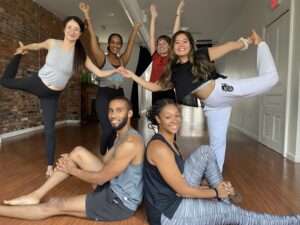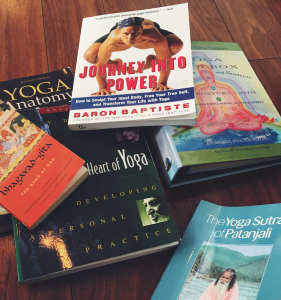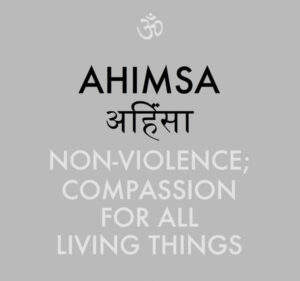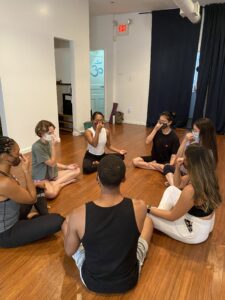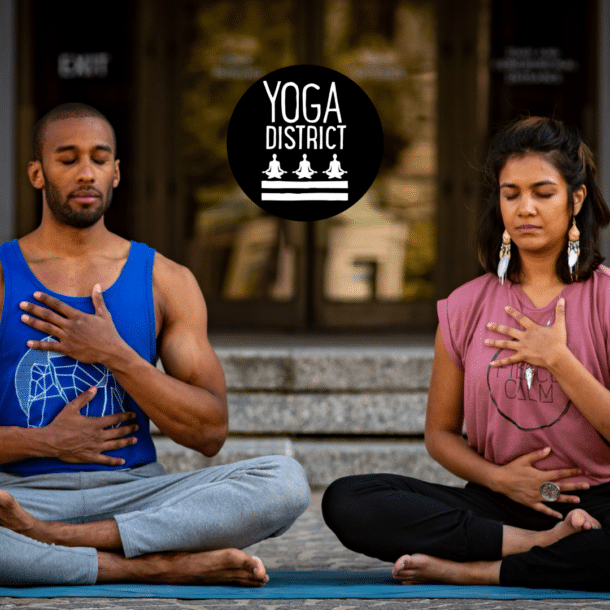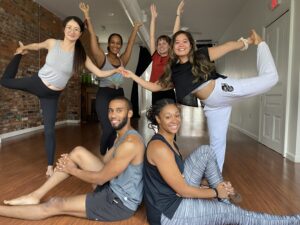 In this blog post, Aaron shares his experiences learning about the holistic nature of Yoga during Yoga District’s 200-hr Yoga Teacher Training (YTT).
In this blog post, Aaron shares his experiences learning about the holistic nature of Yoga during Yoga District’s 200-hr Yoga Teacher Training (YTT).
He now incorporates these teachings in his own practice and looks forward to sharing them with his future students.
Yoga is Holistic
What is yoga? If we explore this question in western popular culture, we might lean towards an answer that highlights a physical practice. And even if we turn to classical texts that laid the foundation for yoga, we can find multiple responses to this seemingly simple question. During Yoga Teacher Training (YTT), I’ve searched for an answer to this question for myself. With the help of my teachers, I’ve found the definition in sutra 1.2 of the Yoga Sutras of Patanjali resonates with me the most. It says: “Yogas citta vrtti nirodhah” (1). Or, when translated to English,  “Yoga is the stilling of the changing states of the mind” (2). As explained to me by my teachers and by the commentators of the Yoga Sutras, it’s in this stillness that the consciousness expands. In this expansion, there is the experience of self-realization. With this expanded consciousness, one starts to see the same universal life force that exists in our own being in all living beings.
“Yoga is the stilling of the changing states of the mind” (2). As explained to me by my teachers and by the commentators of the Yoga Sutras, it’s in this stillness that the consciousness expands. In this expansion, there is the experience of self-realization. With this expanded consciousness, one starts to see the same universal life force that exists in our own being in all living beings.
Classical yogic texts like the Yoga Sutras and the Upanishads provide multiple methods (in addition to asana) to help us practice yoga this way (2, 3). Many of which we’ve explored in our Yoga Teacher Training. Including the practice of yogic ethics such as the active expression of compassion (ahimsa),breathing exercises (pranayama), and chanting (4, 5, 6).
My Yoga Journey before Teacher Training
Like a lot of people, my journey in yoga started with the physical asana practice. But when I got injured and couldn’t move as much, I decided to hone in on meditation with the help of a guided meditation app. After finishing one particular meditation, I remember opening my eyes and being noticeably more present. This wasn’t some grandiose experience of enlightenment or anything. But for me, it was a big contrast from the fluctuating thought patterns that I usually experienced. As I sat there, I was able to take a more objective look at how I was living my life. I realized that going forward, I wanted to live with more kindness and empathy. That’s when it clicked for me. All the things that yoga instructors had said in classes, like, “be present” and “come back to the breath,” started to make sense.
That’s when I started studying the books on Yoga District’s Recommended Reads. Books like: Yoga Sutras of Patañjali by Edwin F. Bryant, Bhagavad-Gita: The Song of Godby by Swami Prabhavananda and Christopher Isherwood, and Autobiography of a Yogi by Paramahansa Yogananda (2, 7, 8 ). As I studied these texts, I was drawn in by the simplicity of their messages. I began implementing aspects of yoga philosophy into my life. I was inspired by the noticeable impact on my relationship with myself and others. After some time, I realized that I could benefit from a more experienced guide to help me navigate these teachings. I was happy to see that Yoga District’s teacher training curriculum went beyond teaching the physical practice and covered some of the other methods to practice yoga as well.
Ahimsa
Towards the second half of YTT, our teacher Jasmine walked us through some of Patanjali’s sutras step by step (9). Jasmine’s analysis took rather complex and sometimes cryptic sutras and broke them down into terms that made it easy to apply to my daily life. From this, I received a greater understanding of the sutras than I had from reading them independently. One sutra analysis that really stood out to me was that of sutra 2.30 which details the yamas (10).
There are 5 yamas, each of which gives advice on how to interact with the world around us:
- Ahimsa: nonviolence/active love
- Satya: truthfulness
- Asteya: non-stealing
- Brahmacharya: non-excess
- Aparigraha: non-greed
The yama that we paid special attention to was ahimsa. Although this Sanskrit term translates to non-violence, Jasmine explained to us that it’s not a passive action. An alternate translation for this term is to actively express compassion. Looking at ahimsa with this additional translation in mind gave me a completely different view of the yama. It also helped me internalize ahimsa in a way where I made several small changes to my interactions with the world. Things like greeting my neighbors on the elevator or picking up trash from the sidewalk.
Pranayama
In our training we also got the chance to learn about and practice breathing exercises (pranayama). Pranayama is something that I was fascinated to learn about in YTT. It had come up so often in the books I read pre-training, but I didn’t have many opportunities to explore it beforehand. In training, towards the beginning of class, our teachers would lead us through various ways of practicing pranayama, like Bhastrika (bellows breath) and Kapalabhati (breath of fire) (11). These exercises are similar and both require contracting the diaphragm to modify our normal breathing pattern. The difference is that with Kapalabhati, the inhale is passive as a result of the “recoil” of the diagram expanding after a strong contraction. With Bhastrika, both the inhale and exhale are results of intentional breathing. We also learned another pranayama exercise called Nadi Shodhana, where a hand is used to help alternate breathing between the nostrils (12).
One of the things I like about pranayama is that it’s made me more aware of my breathing throughout the day. When I find myself in a high stress situation, I’m able to more quickly realize it. In those situations, I can help relax my mind and body by lengthening the duration of my inhales and exhales. That said, I’m still trying to find out where pranayam fits within my own personal practice. Right now, I’m doing pranayama exercises on a daily basis. And I’m going to stick with it for at least a month or so before seeing if I want to replace it with more time practicing asana or meditating.
Chanting
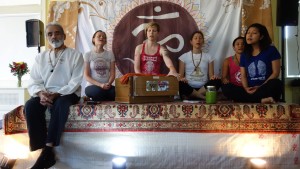 Chanting is an ancient spiritual practice that’s existed for thousands of years. In yoga, like in other traditions, it’s a repetition of a prayer, word, or sound in a song-like way. Before YTT, my exposure to chanting was limited to an “Om” at the beginning and end of public yoga classes. But in training, our teacher Aparna shared with us additional chants using the call and response method. That means if one person says a portion of the chant, then the rest of the class would repeat it. Eventually, we transitioned to chanting all together.
Chanting is an ancient spiritual practice that’s existed for thousands of years. In yoga, like in other traditions, it’s a repetition of a prayer, word, or sound in a song-like way. Before YTT, my exposure to chanting was limited to an “Om” at the beginning and end of public yoga classes. But in training, our teacher Aparna shared with us additional chants using the call and response method. That means if one person says a portion of the chant, then the rest of the class would repeat it. Eventually, we transitioned to chanting all together.
One of these chants is “Lokah Samastah Sukhino Bhavantu” (13). Translated to English, this means “May all beings everywhere be happy and free, and may the thoughts, words, and actions of my own life contribute in some way to that happiness and to that freedom for all.” Aparna led our class through this chant shortly after the events that transpired in the Middle East. Sitting in unison with my class, albeit virtual, and dedicating the chant to lives impacted is something I’ll never forget. We may not have been able to change the situation. Yet in unison with my class, it felt right to acknowledge people’s struggles around the world and to pray for their freedom as well as happiness.
I repeat the “Lokah Samastah Sukhino Bhavantu” chant as a part of my daily yoga practice. Sometimes I sing along with the song by David Lurey (14). Chanting may not be for everyone, and it’s important to respect individuals’ beliefs and comfort levels. I am looking forward to introducing this method of yoga into classes I teach. Students will also have the option to opt out of chanting.
Practicing Yoga Holistically
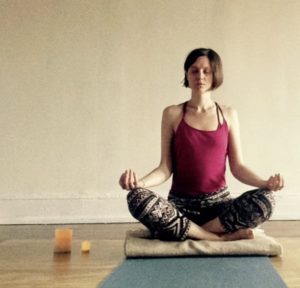 It’s been a privilege to study yoga holistically under the guidance of my teachers. They’ve taught me additional forms of meditation:
It’s been a privilege to study yoga holistically under the guidance of my teachers. They’ve taught me additional forms of meditation:
- Seedless (unsupported) meditation is to meditate without objects or content (15)
- Mantra meditations (16).
Now I have a better understanding of the ethical observances of yoga. The yamas and niyamas. Both of which Patanjali says help to prepare practitioners to move on to the subsequent limbs of yoga (asana, pranayama, etc.). Additionally, my teachers helped me explore the ability to regulate the mind and body with pranayama. And, introduced me to the joy of chanting.
I’ve already started to incorporate what I’ve learned in my personal practice. Now usually after I finish daily asana practice (a mixture of the Rocket I series and Yin Yoga) I move through a series of chanting, pranayama, and meditation exercises (5, 15-17). All of these components of my practice collectively help me feel grounded. They give me the opportunity to reconnect with the true nature of yoga.
Getting the chance to actually lead these exercises in training has given me the confidence to incorporate these techniques into the classes I’ll teach. But I’ll take care not to do this in a pushy way. I know that when I first started yoga I wasn’t at a place in my life where I would’ve been fully receptive to a holistic practice. And had someone tried to introduce things like pranayama and chanting it could’ve easily have pushed me away from the practice. That said, if it wasn’t for the gentle insights and nudges from my teachers, I might’ve never known that there is more to yoga than a physical practice. And consequently, never would’ve had the chance to bring more awareness, kindness and compassion into my life.
So I won’t let the fear of being off-putting prevent me from sharing these various practices with people in my class. And I will look for opportunities to add aspects of meditation, pranayama, and chanting exercises at the end of the classes I teach. But even if my incorporation of holistic yoga into a class is subtle. Like embodying ahimsa and treating each of the people in my class with active compassion. I think that too can be enough. I am, afterall, there to serve. And I appreciate that it’s important to meet people where they are. And adjust my class in a way that’s appropriate for the community I’m serving.
What’s Next
On our last day of the training – we’ll be teaching a full-length class to our classmates. In the next post, I’ll share what we’ve learned about creating a full yoga class, and what the process of creating that class was like for me.
Sources:
- Sutra 1.2 of the Yoga Sutras of Patanjali, https://swamij.com/yoga-sutras-10104.htm#1.2
- The Yoga Sutras of Patanjali, https://books.google.com/books/about/The_Yoga_Sutras_of_Patanjali.html?id=JHYxAQAAIAAJ
- Upanishads, https://www.yogapedia.com/definition/5507/upanishads
- Ahimsa or Non-Harming, https://www.swamij.com/glossary/ahimsa.htm
- Breathing Practices and Pranayama in Yoga, https://swamij.com/breath.htm
- Chanting, https://www.yogapedia.com/definition/7236/chanting
- Bhagavad-Gita: The Song of God, https://www.goodreads.com/book/show/581621.Bhagavad_Gita?from_search=true&from_srp=true&qid=A20aJRJsXU&rank=4
- Autobiography of a Yogi, https://books.google.com/books/about/Autobiography_of_a_Yogi.html?id=Wymi_jlaFI4C
- Yoga Sutras Index of Articles, https://swamij.com/index-yoga-meditation-yoga-sutras.htm
- Yoga Sutras 2.30-2.34: Yamas and Niyamas, https://swamij.com/yoga-sutras-23034.htm
- Kapalbhati versus Bhastrika: Comparing Two Powerful Pranayama Practices, https://www.yogapedia.com/kapalbhati-versus-bhastrika-comparing-two-powerful-pranayama-practices/2/11580
- Nadi Shodhana Pranayama, https://www.banyanbotanicals.com/info/ayurvedic-living/living-ayurveda/yoga/nadi-shodhana-pranayama/
- Lokah Samastah Sukhino Bhavantu, https://jivamuktiyoga.com/fotm/lokah-samastah-sukhino-bhavantu/
- Lokah Samastah Sukhino Bhavantu song by David Lurey, https://www.youtube.com/watch?v=xn7mhcdAqzc
- Seedless (Unsupported) Meditation, https://www.worldyogainstitute.org/2020/05/26/the-yoga-sutras-of-patanjali-part-6/
- Mantra Meditation, https://www.healthline.com/health/mantra-meditation#tips-and-tricks
- Rocket Yoga, https://www.stylecraze.com/articles/rocket-yoga-what-is-it-and-what-are-its-benefits/

